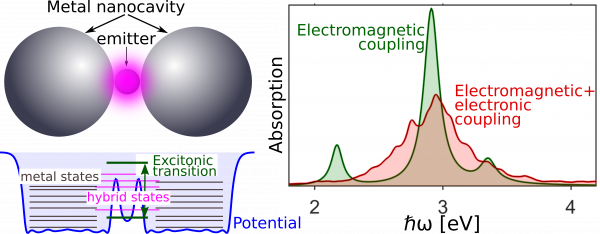Electronic exciton−plasmon coupling in a nanocavity beyond the electromagnetic interaction picture
A quantum many-body description of the interaction between an exciton and plasmonic resonances in a metallic nanocavity indicates that electronic coupling, often ignored by classical electromagnetic calculations, can strongly modify the optical response of the hybrid system, thus influencing the performance of nanoscale optoelectronic devices.
Plasmonic resonances in metallic nanocavities exploit the collective oscillations of free electrons in metals to confine light into nanometer-sized regions, well below the diffraction limit. This large confinement enables a very efficient excitation and interaction with excitons in molecules, quantum dots and other quantum emitters, as typically described within classical electromagnetic frameworks.
A particularly attractive configuration to optically excite an exciton consists in locating a quantum emitter in the gap formed between two metallic nanostructures (sketch in top-left panel). When decreasing the separation distance between the particles the confinement of the electromagnetic fields in the gap is enhanced dramatically. In this work, researchers of CFM, in collaboration with Andrei G. Borisov from the Institut des Sciences Moléculaires d’Orsay in France, go beyond the classical electromagnetic description to show that charge-transfer electronic processes can strongly influence the optical response of this type of hybrid plasmon-exciton systems at very short separation distances, of the order of a nanometer, as revealed by quantum many-body calculations based on Time-Dependent Density Functional Theory (TDDFT).
The TDDFT calculations demonstrate that the electronic states of the quantum emitter can hybridize with those of the metallic nanocavity (bottom left panel), which leads to a quenching of the exciton and to a weaker optical interaction with the plasmonic resonances, as manifested in clear changes on the strength and energy of the peaks of the absorption spectrum (right panel). For instance, if the exciton is resonant with a plasmonic resonance, the electronic quenching limits the value of the vacuum Rabi splitting that separates energetically the hybrid polaritonic modes that arise when the system is in the strong coupling regime. The origin of the predicted effects is corroborated by comparing the quantum TDDFT calculations with classical and semi-classical results. Furthermore, the quantum emitter also facilitates the transfer of electric charge between the metallic nanostructures forming the nanocavity, resulting in the emergence of additional low-energy plasmonic modes. Understanding the interplay between the optical and electronic coupling of excitons and plasmonic resonances is important to optimize light sources and to engineer novel optoelectronic devices.

Figure: Electromagnetic and electronic coupling of an emitter and a metallic nanocavity. (Top Left) Sketch of the system considered. (Botton Left) The electronic coupling between an exciton of the quantum emitter and the metal states of the plasmonic nanocavity results in the emergence of hybrid states that quench the excitonic transition. (Right) Absorption spectra obtained with classical calculations that only consider the electromagnetic coupling (green) or with TDDFT calculations that include both the electromagnetic and the electronic coupling (red). The difference between the TDDFT and classical spectra is mainly due to electronic coupling.



